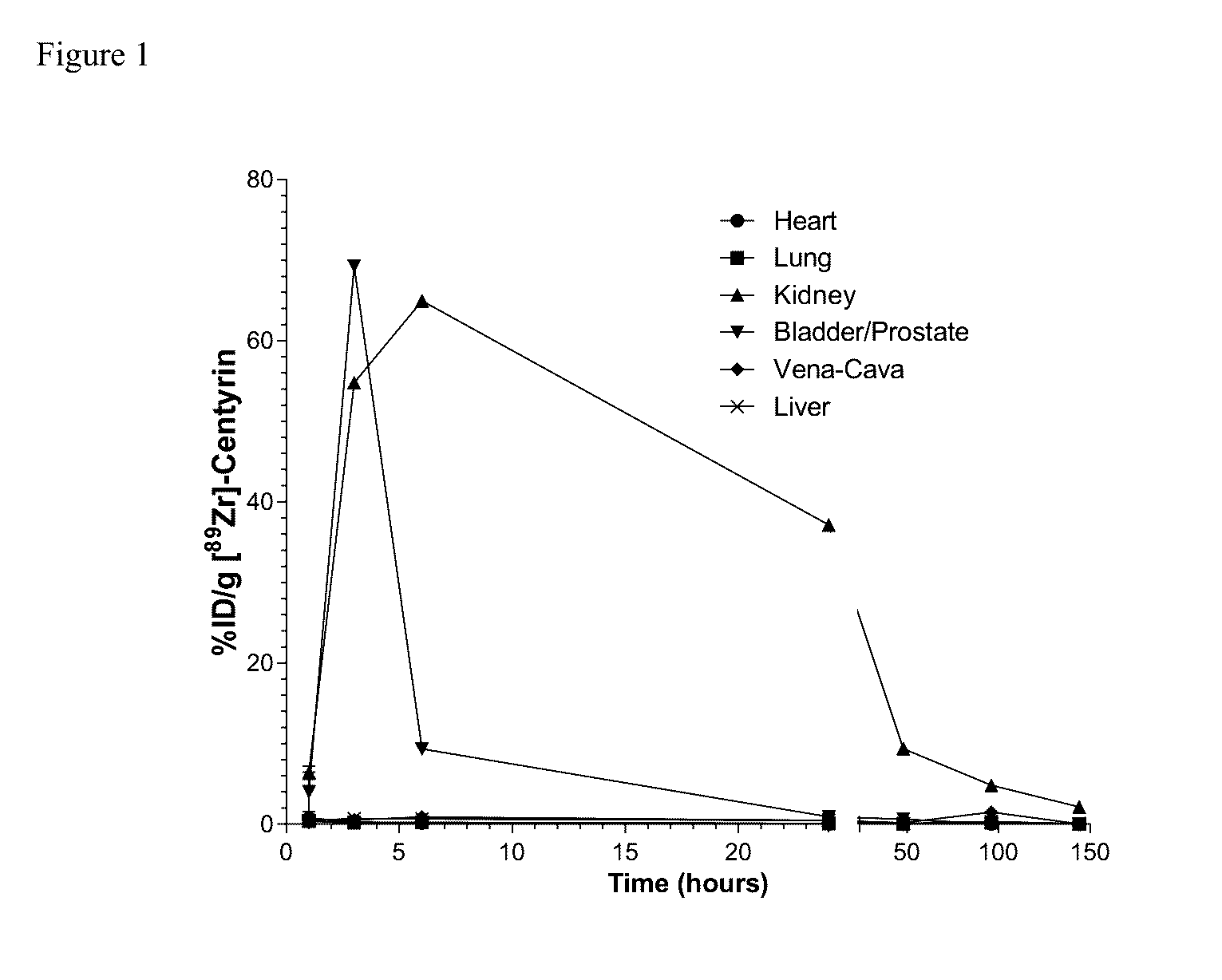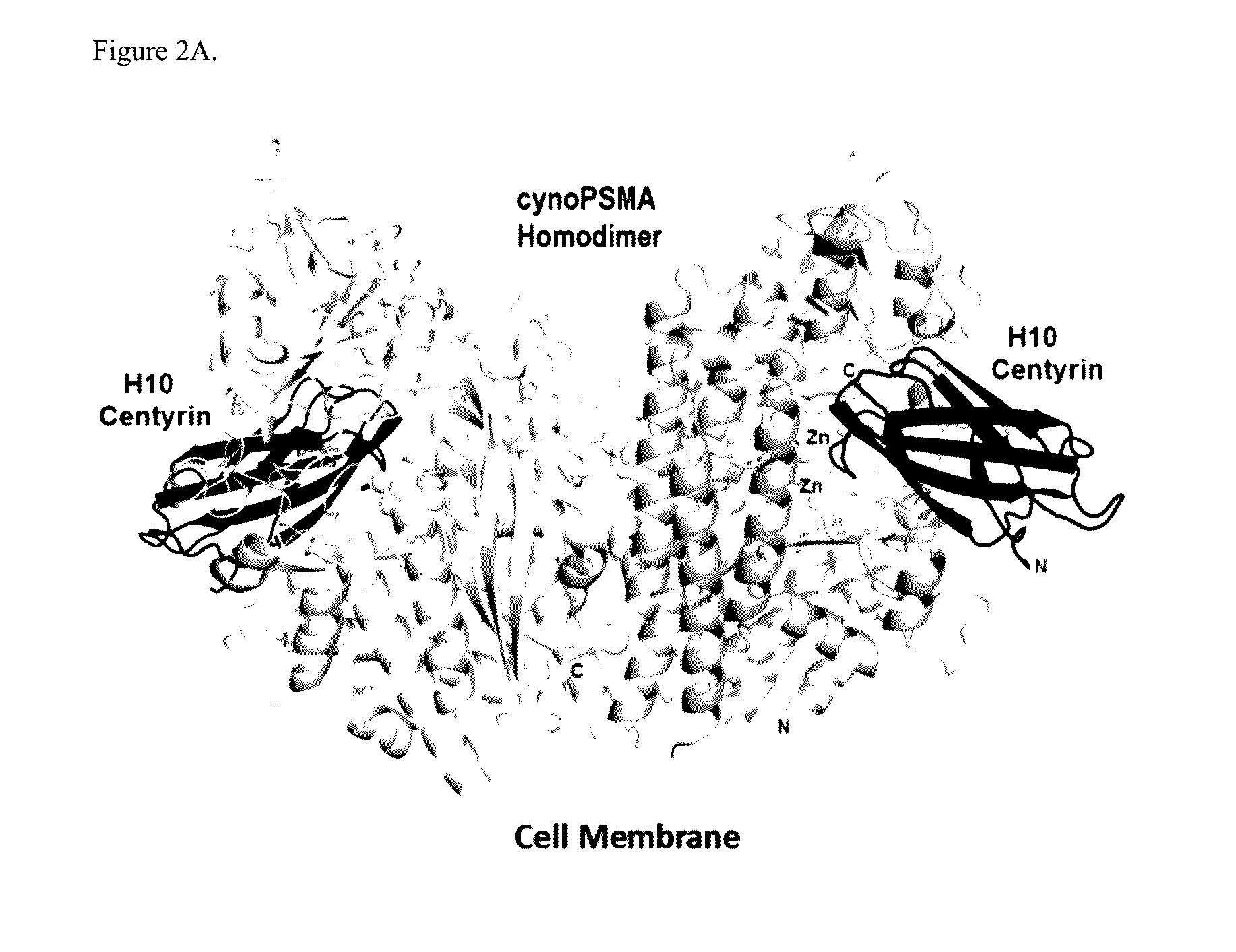Prostate Specific Membrane Antigen Binding Fibronectin Type III Domains
a membrane antigen and prostate cancer technology, applied in the field of prostate specific membrane antigen binding molecules, can solve the problems of limited treatment options, limited clinical efficacy, and often androgen insensitive tumor cells
- Summary
- Abstract
- Description
- Claims
- Application Information
AI Technical Summary
Benefits of technology
Problems solved by technology
Method used
Image
Examples
example 1
Construction of Tencon Libraries with Randomized Loops
[0163]Tencon (SEQ ID NO: 1) is an immunoglobulin-like scaffold, fibronectin type III (FN3) domain, designed from a consensus sequence of fifteen FN3 domains from human tenascin-C (Jacobs et al., Protein Engineering, Design, and Selection, 25:107-117, 2012; U.S. Pat. No. 8,278,419). The crystal structure of Tencon shows six surface-exposed loops that connect seven beta-strands. These loops, or selected residues within each loop, can be randomized in order to construct libraries of fibronectin type III (FN3) domains that can be used to select novel molecules that bind to specific targets.
Tencon:
[0164]
LPAPKNLVVSEVTEDSLRLSWTAPDAAFDSFLIQYQESEKVGEAINLTVPGSERSYDLTGLKPGTEYTVSIYGVKGGHRSNPLSAEFTT (SEQ ID NO1):
Various libraries were generated using the tencon scaffold and various design strategies. In general, libraries TCL1 and TCL2 produced good binders. Generation of TCL1 and TCL2 libraries are described in detail in Int. Pat. Publ. No. ...
example 2
Generation of Tencon Libraries Having Alternative Binding Surfaces
[0177]The choice of residues to be randomized in a particular library design governs the overall shape of the interaction surface created. X-ray crystallographic analysis of an FN3 domain containing scaffold protein selected to bind maltose binding protein (MBP) from a library in which the BC, DE, and FG loops were randomized was shown to have a largely curved interface that fits into the active site of MBP (Koide et al., Proc Natl Acad Sci USA 104: 6632-6637, 2007). In contrast, an ankyrin repeat scaffold protein that was selected to bind to MBP was found to have a much more planar interaction surface and to bind to the outer surface of MBP distant from the active (Binz et al., Nat Biotechnol 22: 575-582, 2004). These results suggest that the shape of the binding surface of a scaffold molecule (curved vs. flat) may dictate what target proteins or specific epitopes on those target proteins are able to be bound effecti...
example 3
Selection of Fibronectin Type III (FN3) Domains that Bind PSMA Plate-Based Selections
[0186]CIS-display was used to select PSMA binding Centyrins from the TCL7, TCL9, TCL19, and TCL21 libraries. For in vitro transcription and translation (ITT), 3 μg of library DNA were incubated at 30° C. with 0.1 mM complete amino acids, 1×S30 premix components, and 15 μL of S30 extract (Promega) in a total volume of 50 μL. After 1 hour, 375 μL of blocking solution (1×TBS pH 7.4, 0.01% I-block (Life Technologies, #T2015), 100 ug / ml herring sperm DNA) was added and reactions were incubated on ice for 15 minutes. ITT reactions were incubated with recombinant proteins, chimpanzee (pan 229) or cynomolgus monkey PSMA (pan 230), or cynomolgus monkey PSMA-Fc fusion (pan 231), which were immobilized on anti-human PSMA antibody (Lifespan Bioscience, catalog # LC-C150527) coated 96-well Maxisorb plates. Unbound library members were removed by successive washes with TBST and TBS. After washing, DNA was eluted ...
PUM
| Property | Measurement | Unit |
|---|---|---|
| dissociation constant | aaaaa | aaaaa |
| dissociation constant | aaaaa | aaaaa |
| dissociation constant | aaaaa | aaaaa |
Abstract
Description
Claims
Application Information
 Login to View More
Login to View More - R&D
- Intellectual Property
- Life Sciences
- Materials
- Tech Scout
- Unparalleled Data Quality
- Higher Quality Content
- 60% Fewer Hallucinations
Browse by: Latest US Patents, China's latest patents, Technical Efficacy Thesaurus, Application Domain, Technology Topic, Popular Technical Reports.
© 2025 PatSnap. All rights reserved.Legal|Privacy policy|Modern Slavery Act Transparency Statement|Sitemap|About US| Contact US: help@patsnap.com



